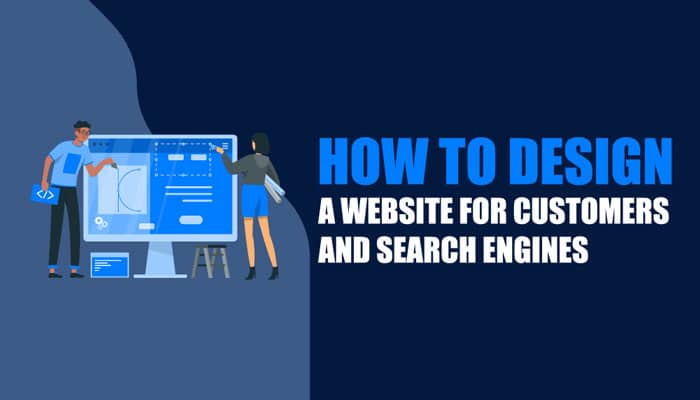A web design is a blend of many variables, such as images, fonts, speed, responsiveness, SEO, etc.
Out of all these variables, SEO is the most emphasized variable because it is directly linked to your rankings.
We are not trying to demean the importance of SEO, but is it the only thing businesses need to care about?
We are designing websites for Google bots and not for the end customer who will be buying our product.
Before we go through the points to help you design a robust website, let us look at what happens when a site is made, focusing on search engines and not on the end customer.
Why should a site’s design be focused on customer satisfaction and not entirely on a search engine?
Business owners think they have to make their site rank higher and call it done, whereas the truth is that when a customer visits a page and doesn’t find it helpful, he/she immediately leaves it.
This leads to an increase in the site’s bounce rates. Google not only considers a site’s traffic but also monitors where the traffic is going.
If Google finds that the traffic is bouncing back, it considers it unworthy of ranking on top and brings the rankings down.
Thus, it is essential to focus on customer satisfaction instead of search engine algorithms because the only way to gain rankings is by satisfying your customer.
How to design a website for both customers and search engines?
1. Ensure that your website is customer-centric.
It does not matter what you like about your product or service; what your customer wants is all that is worth talking about.
You must ask yourself why a customer would want to visit my website? What would he like to see? Why should he buy my product?
Before designing your site, you must find answers to these questions to create a customer-centric website.
2. Create an intuitive site structure
A robust site is one that has a surgically, precise site structure. Although Google bots are quite smart in finding content from your website, they still lack the human ability to perceive things.
Thus, as business owners, we have to help them crawl and understand our site correctly.
Site structures should not be rigid, and to ensure that same, websites need to build internal and external links.
Links help search engine crawlers determine content relevance. But ensure that links are appropriately working and not broken.
Otherwise, your site can take a severe ranking dip. Site structuring aims to provide equal emphasis to search engines and customers.
3. Quality content should be your success mantra.
If a website has a robust design but lacks quality content, it can never attain the desired search rankings.
Businesses should focus on gaining traction through blogs and articles without compromising the quality of the content.
Ask these questions before writing content:
- Why am I building this content piece?
- Will this content piece be valuable to my customers?
- What am I trying to achieve through this blog post?]
- What do I want my reader to do after reading the blog?
4. Image management should be given due importance.
Images are an essential part of your site. Quality images add freshness and engagement to well-written content.
Image size plays an essential role in controlling your site speed. High-quality images also take much time to load, increasing your site’s load time.
According to Google, if a site takes more than 3 seconds to load, there is a 32% chance that its visitors will bounce back.
So, as businesses, we cannot compromise on load time to make our content look good.
The best way to deal with that is by compressing your image size through a software of plugins.
5. Maintain track of your site’s speed.
As we discussed in the previous point, your site’s speed is a thing to worry about. Ensure that your site does not take more than 3 seconds to load.
Apart from optimizing images and videos, you must also remove unused plugins to fill your site up.
Keep minimum plugins on your site to avoid bloating and give a smooth experience to your customers. Also, keep your HTTPS redirects to the minimum.
High site speed results in fewer bounce rates and improves customer and search engine trust.
6. A responsive design is a good design.
The world has moved from desktop to mobile and tablets. Nowadays, more users surf the internet from their mobile devices than their desktops.
So, businesses need to create responsive websites that are equally effective when surfed from mobile as they are from desktops.
Search engines like Google also monitor a website’s performance from smartphones these days, which means that a business must make its site a mobile-centric one to rank higher.
7. Site security is a must.
Google has made it mandatory for all websites to install security protocols like SSL certificate.
Google will not rank any website that does not have an SSL installed already.
Moreover, customers have gotten advanced these days. They understand the value of grey padlock ahead of the HTTPS (Hypertext Transfer Protocol Secure).
Most customers would immediately bounce back from a site if they find HTTP instead of HTTPS ahead of the site’s URL, which is why it is nearly impossible to fool customers these days.
SSL/TLS certificates not only help you gain search engine and customer trust but also protect your website from the onslaught of cybercriminals in the form of malware, spyware, and ransomware attacks
.
Conclusion
As businesses, it is essential to create a balance between customer satisfaction and search engine algorithms.
Both search engines and customers are linked to each other. Search engines are always on the lookout for websites that add value to the customer experience.
So, follow the steps discussed above and create a robust website design that enhances the customer experience and pleases the search engine crawlers.


